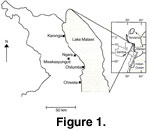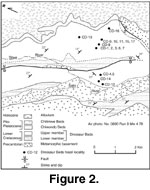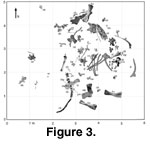INTRODUCTION
Titanosaurian dinosaurs were one of
the most widely distributed groups of sauropods during the Cretaceous Period. At
least two, perhaps three, taxa of sauropods have been discovered in Malawi
including Malawisaurus, which is considered to belong to the Titanosauria
(Bonaparte and Coria 1993;
Wilson 2002;
Wilson and Sereno 1998), and a new taxon.
 The goals of this study are to describe the material of sauropod dinosaurs from
Malawi, which is mostly Malawisaurus, and to name the new sauropod taxon,
which is represented by a dentary, isolated teeth, and possibly vertebrae.
Malawisaurus has not previously been fully described and illustrated
although it has been incorporated into numerous phylogenetic analyses.
The goals of this study are to describe the material of sauropod dinosaurs from
Malawi, which is mostly Malawisaurus, and to name the new sauropod taxon,
which is represented by a dentary, isolated teeth, and possibly vertebrae.
Malawisaurus has not previously been fully described and illustrated
although it has been incorporated into numerous phylogenetic analyses.
All the specimens
described here were collected from the same area of the Dinosaur Beds (Dixey
1928;
Jacobs et al. 1990,
1992) near Mwakasyunguti, Karonga District, northern
Malawi (Figure 1). The Dinosaur Beds are considered to be of Early Cretaceous (?Aptian)
age, based on biochronology (Colin and Jacobs 1990) and regional proximity to carbonatites (K-Ar dates of 123 + 3 to 111 + 13.1 Ma) to the north and south of
the study area (Pentel’kov and Voronovsky 1979;
Eby et al. 1995).
 Materials and Methods
Materials and Methods
Fossils were collected
in 1987, 1989, 1990, and 1992 field expeditions by the Malawi Dinosaur Project (MDP),
a joint project between the Malawi Department of Antiquities and Southern
Methodist University (SMU), Dallas, Texas, USA.
 The project opened up 17
quarries designated by the prefix CD followed by a sequential quarry number.
More than half the specimens presented here were collected from CD-9 (Figure 2
and Figure 3). The specimens collected by the MDP and utilized in this study are listed
in Table 1. The specimens
are catalogued as Mal followed by a number. Numbers following catalogue numbers
indicate individual elements that were articulated or associated in the field.
Specimens referred to Malawisaurus in the
South African Museum and in the
Natural History Museum, London, were also examined.
Taxa that are well known, or have comparable elements to those from Malawi, or
are known from other African regions, were used for comparison (Appendix 1).
Anatomical and institutional abbreviations are listed in
Appendix 2.
The project opened up 17
quarries designated by the prefix CD followed by a sequential quarry number.
More than half the specimens presented here were collected from CD-9 (Figure 2
and Figure 3). The specimens collected by the MDP and utilized in this study are listed
in Table 1. The specimens
are catalogued as Mal followed by a number. Numbers following catalogue numbers
indicate individual elements that were articulated or associated in the field.
Specimens referred to Malawisaurus in the
South African Museum and in the
Natural History Museum, London, were also examined.
Taxa that are well known, or have comparable elements to those from Malawi, or
are known from other African regions, were used for comparison (Appendix 1).
Anatomical and institutional abbreviations are listed in
Appendix 2.

 The goals of this study are to describe the material of sauropod dinosaurs from
Malawi, which is mostly Malawisaurus, and to name the new sauropod taxon,
which is represented by a dentary, isolated teeth, and possibly vertebrae.
Malawisaurus has not previously been fully described and illustrated
although it has been incorporated into numerous phylogenetic analyses.
The goals of this study are to describe the material of sauropod dinosaurs from
Malawi, which is mostly Malawisaurus, and to name the new sauropod taxon,
which is represented by a dentary, isolated teeth, and possibly vertebrae.
Malawisaurus has not previously been fully described and illustrated
although it has been incorporated into numerous phylogenetic analyses. 
